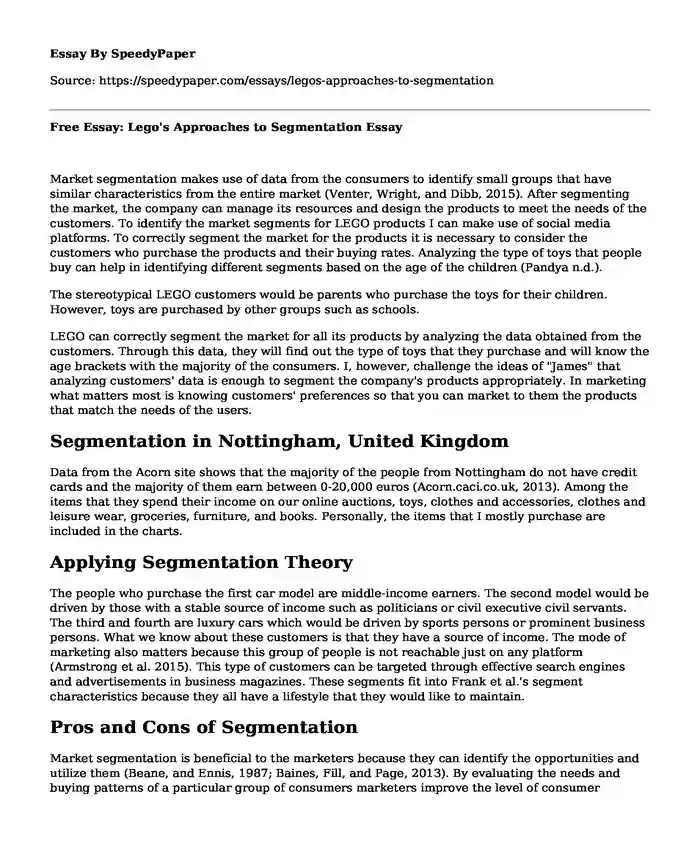Market segmentation makes use of data from the consumers to identify small groups that have similar characteristics from the entire market (Venter, Wright, and Dibb, 2015). After segmenting the market, the company can manage its resources and design the products to meet the needs of the customers. To identify the market segments for LEGO products I can make use of social media platforms. To correctly segment the market for the products it is necessary to consider the customers who purchase the products and their buying rates. Analyzing the type of toys that people buy can help in identifying different segments based on the age of the children (Pandya n.d.).
The stereotypical LEGO customers would be parents who purchase the toys for their children. However, toys are purchased by other groups such as schools.
LEGO can correctly segment the market for all its products by analyzing the data obtained from the customers. Through this data, they will find out the type of toys that they purchase and will know the age brackets with the majority of the consumers. I, however, challenge the ideas of "James" that analyzing customers' data is enough to segment the company's products appropriately. In marketing what matters most is knowing customers' preferences so that you can market to them the products that match the needs of the users.
Segmentation in Nottingham, United Kingdom
Data from the Acorn site shows that the majority of the people from Nottingham do not have credit cards and the majority of them earn between 0-20,000 euros (Acorn.caci.co.uk, 2013). Among the items that they spend their income on our online auctions, toys, clothes and accessories, clothes and leisure wear, groceries, furniture, and books. Personally, the items that I mostly purchase are included in the charts.
Applying Segmentation Theory
The people who purchase the first car model are middle-income earners. The second model would be driven by those with a stable source of income such as politicians or civil executive civil servants. The third and fourth are luxury cars which would be driven by sports persons or prominent business persons. What we know about these customers is that they have a source of income. The mode of marketing also matters because this group of people is not reachable just on any platform (Armstrong et al. 2015). This type of customers can be targeted through effective search engines and advertisements in business magazines. These segments fit into Frank et al.'s segment characteristics because they all have a lifestyle that they would like to maintain.
Pros and Cons of Segmentation
Market segmentation is beneficial to the marketers because they can identify the opportunities and utilize them (Beane, and Ennis, 1987; Baines, Fill, and Page, 2013). By evaluating the needs and buying patterns of a particular group of consumers marketers improve the level of consumer satisfaction. Through segmentation, the marketer can effectively allocate funds for the marketing tools. The marketer can also modify the product to meet the needs of the target customers. Segmentation facilitates the setting of realistic sales targets. Market segmentation acts as a threat because it increases the costs. It also becomes ineffective if the market segment changes.
Psychographic segmentation is the most effective approach of segmentation because the marketer gets information on what motivates potential customers (Group 2016). Product differentiation can be used instead of market segmentation. Product loyalty is created through differentiation of products. A differentiated product attracts the interest of customers who develop a belief that the product is better than its substitutes from the competitors.
List of References
Acorn.caci.co.uk. (2013). FINANCIALLY STRETCHED. [Online] Available at https://acorn.caci.co.uk/data/#c4_p6 [Accessed 6 Apr. 2019].
Acorn.caci.co.uk. (2013). FINANCIALLY STRETCHED. [Online] Available at https://acorn.caci.co.uk/data/#c4_p7 [Accessed 6 Apr. 2019].
Armstrong, G., Kotler, P., Buchwitz, L.A., Trifts, V., and Gaudet, D. (2015). Marketing: an introduction.
Baines, P., Fill, C. and Page, K. (2013). Essentials of marketing. Oxford University Press.
Beane, T.P. and Ennis, D.M. (1987). Market segmentation: a review. European journal of marketing, 21(5), pp.20-42. https://www.sciencedirect.com/science/article/abs/pii/0019850185900458
Group, P. (2016). 6 Ways to Differentiate Your Business from the Competition. [Online] Blog.marketresearch.com. Available at: https://blog.marketresearch.com/6-ways-to-differentiate-your-business-from-the-competition [Accessed 3 Apr. 2019].
Pandya, M. (n.d.). Lego: Identifying the market segment | Lego | Digital & Social Media. [Online] Scribd. Available at: https://www.scribd.com/doc/125970465/Lego-Identifying-the-market-segment [Accessed 3 Apr. 2019].
Venter, P., Wright, A. and Dibb, S. (2015). Performing market segmentation: a performative perspective. Journal of Marketing Management, 31(1-2), pp.62-83. https://www.tandfonline.com/doi/abs/10.1080/0267257X.2014.980437
Cite this page
Free Essay: Lego's Approaches to Segmentation. (2022, Dec 09). Retrieved from https://speedypaper.com/essays/legos-approaches-to-segmentation
Request Removal
If you are the original author of this essay and no longer wish to have it published on the SpeedyPaper website, please click below to request its removal:
- Free Essay on How to Find Inspiration for Writing
- Racial Profiling Essay Sample
- Essay Example on Investigating Relevance of Historic Curriculum to Learners
- Essay Sample: Description of Biodiversity
- Victimology Annotated Bibliography, Free Example for You
- Paper Example. Trade War Between the United States and China
- Free Essay: A Summary of a Group Work on Applying Stages of Change to Complex Behaviors
Popular categories





